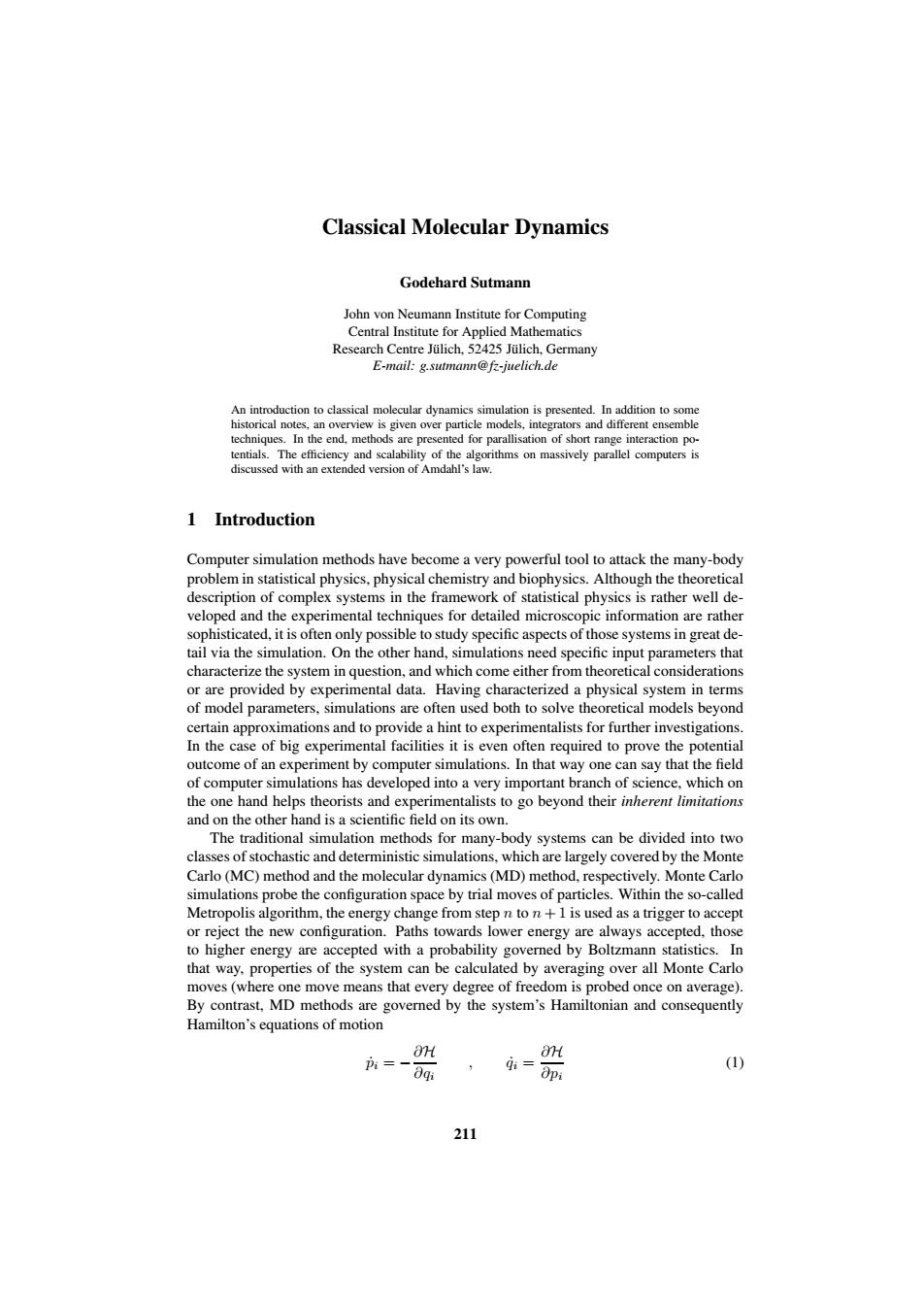正在加载图片...

Classical Molecular Dynamics Godehard Sutmann John von Neumann Institute for Computing Central Institute for Applied Mathematics Research Centre Julich,52425 Julich,Germany E-mail:g.sutmann@fz-juelich.de An introduction to classical molecular dynamics simulation is presented.In addition to some historical notes,an overview is given over particle models,integrators and different ensemble techniques.In the end,methods are presented for parallisation of short range interaction po- tentials.The efficiency and scalability of the algorithms on massively parallel computers is discussed with an extended version of Amdahl's law. 1 Introduction Computer simulation methods have become a very powerful tool to attack the many-body problem in statistical physics.physical chemistry and biophysics.Although the theoretical description of complex systems in the framework of statistical physics is rather well de- veloped and the experimental techniques for detailed microscopic information are rather sophisticated,it is often only possible to study specific aspects of those systems in great de- tail via the simulation.On the other hand,simulations need specific input parameters that characterize the system in question,and which come either from theoretical considerations or are provided by experimental data.Having characterized a physical system in terms of model parameters.simulations are often used both to solve theoretical models beyond certain approximations and to provide a hint to experimentalists for further investigations. In the case of big experimental facilities it is even often required to prove the potential outcome of an experiment by computer simulations.In that way one can say that the field of computer simulations has developed into a very important branch of science,which on the one hand helps theorists and experimentalists to go beyond their inherent limitations and on the other hand is a scientific field on its own. The traditional simulation methods for many-body systems can be divided into two classes of stochastic and deterministic simulations.which are largely covered by the Monte Carlo(MC)method and the molecular dynamics(MD)method,respectively.Monte Carlo simulations probe the configuration space by trial moves of particles.Within the so-called Metropolis algorithm,the energy change from step n to n+1 is used as a trigger to accept or reject the new configuration.Paths towards lower energy are always accepted,those to higher energy are accepted with a probability governed by Boltzmann statistics.In that way,properties of the system can be calculated by averaging over all Monte Carlo moves (where one move means that every degree of freedom is probed once on average). By contrast,MD methods are governed by the system's Hamiltonian and consequently Hamilton's equations of motion OH OH p=- qi= Opi (1) dgi 211Classical Molecular Dynamics Godehard Sutmann John von Neumann Institute for Computing Central Institute for Applied Mathematics Research Centre Julich, ¨ 52425 Julich, ¨ Germany E-mail: g.sutmann@fz-juelich.de An introduction to classical molecular dynamics simulation is presented. In addition to some historical notes, an overview is given over particle models, integrators and different ensemble techniques. In the end, methods are presented for parallisation of short range interaction potentials. The efficiency and scalability of the algorithms on massively parallel computers is discussed with an extended version of Amdahl’s law. 1 Introduction Computer simulation methods have become a very powerful tool to attack the many-body problem in statistical physics, physical chemistry and biophysics. Although the theoretical description of complex systems in the framework of statistical physics is rather well developed and the experimental techniques for detailed microscopic information are rather sophisticated, it is often only possible to study specific aspects of those systems in great detail via the simulation. On the other hand, simulations need specific input parameters that characterize the system in question, and which come either from theoretical considerations or are provided by experimental data. Having characterized a physical system in terms of model parameters, simulations are often used both to solve theoretical models beyond certain approximations and to provide a hint to experimentalists for further investigations. In the case of big experimental facilities it is even often required to prove the potential outcome of an experiment by computer simulations. In that way one can say that the field of computer simulations has developed into a very important branch of science, which on the one hand helps theorists and experimentalists to go beyond their inherent limitations and on the other hand is a scientific field on its own. The traditional simulation methods for many-body systems can be divided into two classes of stochastic and deterministic simulations, which are largely covered by the Monte Carlo (MC) method and the molecular dynamics (MD) method, respectively. Monte Carlo simulations probe the configuration space by trial moves of particles. Within the so-called Metropolis algorithm, the energy change from step n to n + 1 is used as a trigger to accept or reject the new configuration. Paths towards lower energy are always accepted, those to higher energy are accepted with a probability governed by Boltzmann statistics. In that way, properties of the system can be calculated by averaging over all Monte Carlo moves (where one move means that every degree of freedom is probed once on average). By contrast, MD methods are governed by the system’s Hamiltonian and consequently Hamilton’s equations of motion p˙i = − ∂H ∂qi , q˙i = ∂H ∂pi (1) 211